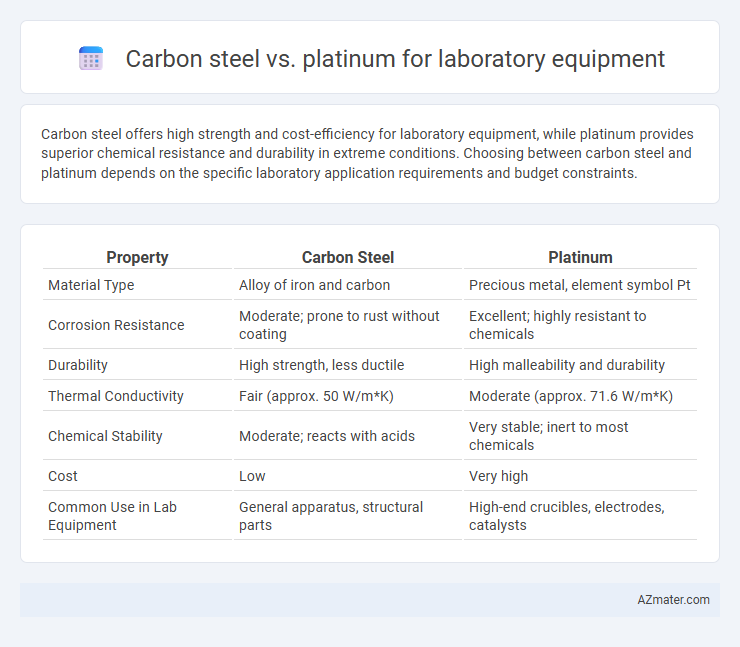Carbon steel offers high strength and cost-efficiency for laboratory equipment, while platinum provides superior chemical resistance and durability in extreme conditions. Choosing between carbon steel and platinum depends on the specific laboratory application requirements and budget constraints.
Table of Comparison
| Property | Carbon Steel | Platinum |
|---|---|---|
| Material Type | Alloy of iron and carbon | Precious metal, element symbol Pt |
| Corrosion Resistance | Moderate; prone to rust without coating | Excellent; highly resistant to chemicals |
| Durability | High strength, less ductile | High malleability and durability |
| Thermal Conductivity | Fair (approx. 50 W/m*K) | Moderate (approx. 71.6 W/m*K) |
| Chemical Stability | Moderate; reacts with acids | Very stable; inert to most chemicals |
| Cost | Low | Very high |
| Common Use in Lab Equipment | General apparatus, structural parts | High-end crucibles, electrodes, catalysts |
Introduction to Laboratory Equipment Materials
Carbon steel offers excellent durability and cost-effectiveness for laboratory equipment, with strong resistance to mechanical stress but moderate corrosion resistance. Platinum, prized for its exceptional chemical inertness and high melting point, is ideal for applications requiring minimal contamination and extreme temperature stability. Selecting the appropriate material depends on balancing factors like chemical compatibility, durability, and cost-efficiency tailored to specific laboratory processes.
Overview of Carbon Steel in Laboratory Applications
Carbon steel offers exceptional strength and durability, making it ideal for laboratory equipment that undergoes frequent handling and mechanical stress. Its high resistance to wear and corrosion ensures longevity in various lab environments, particularly where exposure to non-corrosive chemicals occurs. The material's affordability and ease of fabrication contribute to its widespread use in laboratory tools such as clamps, stands, and cutting instruments.
Overview of Platinum in Laboratory Applications
Platinum is highly valued in laboratory applications for its exceptional corrosion resistance, high melting point of 1,768degC, and excellent catalytic properties, making it ideal for use in crucibles, electrodes, and thermocouples. Its inertness ensures that it does not react with most chemicals, providing reliable and contamination-free results in precise experiments. While Platinum is significantly more expensive than carbon steel, its durability and stability under extreme conditions justify its use in critical scientific research and industrial processes.
Chemical Resistance: Carbon Steel vs Platinum
Platinum exhibits superior chemical resistance compared to carbon steel, maintaining stability and inertness in highly corrosive and acidic laboratory environments. Carbon steel tends to corrode and degrade when exposed to strong acids, bases, and oxidizing agents, limiting its suitability for long-term use in aggressive chemical applications. The exceptional resistance of platinum to oxidation, sulfur compounds, and chemical attack makes it the preferred choice for equipment handling reactive substances and ensuring contamination-free experiments.
Durability and Longevity Comparison
Carbon steel laboratory equipment offers excellent durability with high tensile strength and resistance to wear, but it is prone to corrosion if not properly maintained. Platinum, being a noble metal, provides superior longevity through its exceptional resistance to oxidation, chemical reactions, and high temperatures, making it ideal for harsh laboratory environments. While platinum equipment is more expensive, its unparalleled lifespan and minimal maintenance requirements often justify the investment for long-term applications.
Thermal Stability and Conductivity
Carbon steel offers excellent thermal stability with a high melting point around 1425-1540degC, making it suitable for high-temperature laboratory applications. Platinum exceeds carbon steel in thermal conductivity, approximately 71.6 W/m*K compared to carbon steel's 54 W/m*K, ensuring efficient heat transfer during scientific experiments. The superior corrosion resistance and chemical inertness of platinum further enhance its performance in precise thermal contexts.
Cost Analysis and Economic Considerations
Carbon steel laboratory equipment offers a cost-effective alternative to platinum, with significantly lower initial investment and reduced manufacturing expenses, making it suitable for budget-conscious facilities. Platinum's high resistance to corrosion and excellent durability justify its premium price in specialized applications requiring chemical inertness and longevity. When evaluating economic considerations, the lower maintenance and replacement frequency of platinum can offset its upfront cost in long-term, high-precision laboratory environments.
Maintenance and Cleaning Requirements
Carbon steel laboratory equipment requires regular maintenance to prevent rust and corrosion, including thorough drying and occasional oiling after cleaning, while platinum equipment offers superior resistance to corrosion and oxidation, minimizing maintenance needs. Cleaning carbon steel often demands mild detergents and non-abrasive methods to preserve its protective coating, whereas platinum withstands aggressive cleaning agents and high temperatures without degradation. The durability and inertness of platinum reduce downtime and replacement costs, making it favorable for long-term laboratory use despite higher initial investment.
Suitability for Different Laboratory Environments
Carbon steel offers high durability and resistance to impact, making it suitable for general laboratory tasks involving mechanical stress, but it may corrode in acidic or humid environments. Platinum, with exceptional chemical inertness and high resistance to corrosion and oxidation, is ideal for highly corrosive or high-temperature laboratory applications such as catalytic experiments and corrosive reagent handling. The choice between carbon steel and platinum depends on the specific laboratory environment, with platinum preferred for extreme chemical exposure and carbon steel advantageous for cost-effective, robust equipment in less aggressive conditions.
Conclusion: Choosing the Right Material for Laboratory Equipment
Carbon steel offers excellent durability and cost-effectiveness, making it ideal for general laboratory tools that require strength and resistance to wear. Platinum provides superior chemical inertness and corrosion resistance, essential for precise analytical instruments and equipment exposed to harsh chemicals. Selecting the right material depends on balancing budget constraints with the specific chemical and thermal demands of the laboratory environment.

Infographic: Carbon steel vs Platinum for Laboratory equipment
 azmater.com
azmater.com